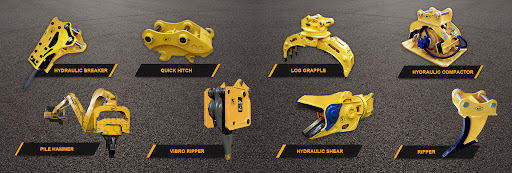Excavators are strong and flexible machines used in construction, landscaping, and demolition. What makes them truly versatile is their wide range of attachments, each designed for specific tasks. Excavator attachments allow one machine to do many jobs, making it highly useful across industries. Knowing which attachment to use and how it works can help you complete projects more efficiently and effectively.
Table of Contents
Why Are Excavator Attachments Important?
Excavator attachments turn a regular machine into a multi-purpose tool that can dig, lift, break, and compact materials. Choosing the right attachment for the job is essential for working safely and efficiently. For example:
- Some attachments handle soft soil,
- Others are made to break through hard concrete,
- Some are perfect for digging precise holes.
Using the correct attachment saves time and prevents unnecessary wear and tear on the machine. With the right tool, tasks become quicker, safer, and more productive.
Common Types of Excavator Attachments
Here are some popular excavator attachments and their uses:
- Buckets
Buckets are the most common attachment and come in different sizes and designs.
- General-purpose buckets are great for moving loose materials like soil and gravel.
- Trenching buckets are narrower and designed to dig precise trenches, ideal for utility work.
- Rock buckets are extra tough and made for handling heavy materials like rocks and debris.
- Hydraulic Breakers
Hydraulic breakers, or hammers, are used in demolition. They break through hard materials like concrete, stone, and asphalt. These are perfect for tearing down buildings or breaking solid ground in roadwork.
- Augers
Augers are tools for drilling holes.
- They are used in landscaping, construction, and farming.
- Tasks like planting trees, installing fence posts, or creating deep holes for foundations are made easy with augers.
- Their spiral design lets them drill through soil, even rocky ground.
Advanced Attachments for Better Performance
Some advanced tools make excavators even more efficient:
- Tilt Rotators: These attachments let operators tilt and rotate buckets or grapples at different angles. This is helpful for detailed tasks like shaping slopes or working in tight spaces.
- Compactors: Compactors are used to press down soil or materials, creating firm and stable surfaces for roads and construction.
These advanced tools save time and effort, making complex tasks easier and faster.
How to Choose the Right Attachment
To pick the right excavator attachment, think about your project’s needs:
- What materials will you work with?
- For breaking concrete, a hydraulic breaker works best.
- For drilling holes, choose an auger.
- Make sure the attachment is compatible with your excavator model.
- Consult with equipment experts for advice on the best tools.
Using the correct attachment ensures better results, lower costs, and fewer operational issues.
Conclusion
Excavator attachments unlock the full potential of these machines. From buckets to augers and advanced tools like tilt rotators, each attachment makes specific tasks easier and more precise. Choosing the right tool, maintaining it well, and using it correctly can boost productivity and safety on any project. By investing in quality attachments, you can get the best results and make your excavator a more valuable asset.

